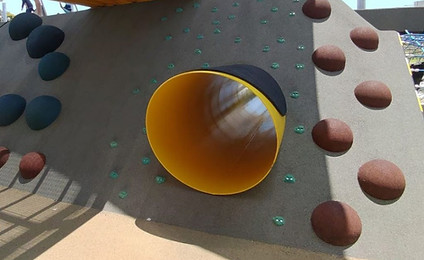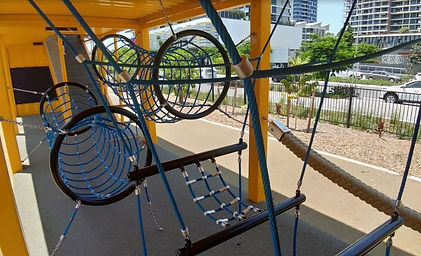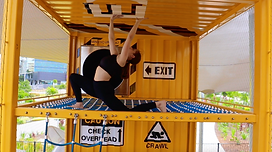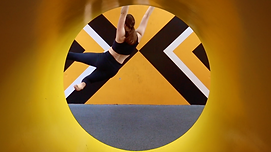
MIND TRAPPED
Playing on the idea of restricted spaces, “Mind Trapped” is a screen dance work that aims to emphasise one’s ‘trapped mentality’ with claustrophobia in a tight space. Claustrophobia is a common fear that is triggered by confined spaces and affects 5-7% of the world population (Healthline, 2020). Inspired by a Rambert Dance collaborator, this short dance film aims to capture the panic and frustration of one through movement in restricted spaces located in a playground. The subtle movement of other individuals outside of the space being danced in, contrasts to the concept purposefully, as these people are seen as feeling ‘free’.
DEVELOPMENT
Learning Process
Sue Healey: Creating and analysing dance on film Part 2. Dance and the Integration of technology
Key ideas consider when creating a screen dance work:
-
Using a high speed camera – movement can be slowed down so the human eye can understand and feel the movements they cant normally see
-
Shape and craft what you want the audience to see
-
Challenge ideas about space and time
-
Variety of scales of shot and angles to view the body allows you to see different perspectives
-
The drama of the close up compared with the objectivity with extreme distance
-
Timing can be manipulated
-
Your imagination is the only limitation for creating a space to dance within
-
The camera has a personality or point of view
-
The audience can become the choreographer as they watch
'間 Ma—The Space Between All Things'
1. What are your initial judgements? Do you like the film or parts of it? Or do you dislike it? And Why?
I personally really enjoyed watching this film. My initial thought was that the dancer was stranded by herself. For example, at the beginning, the camera starts a fair way from the dancer and slowly becomes closer and further away as the piece goes on, making me feel as though I was the person filming there in that exact moment.
2. What are the qualities of the site/ location? How does this contribute to the film?
The locations seem cold, windy and empty and this has been portrayed through the wind effects moving on the floor and in the
dancers hair, the dull colours throughout, and the wide camera angles that make the space look larger. For me as a viewer, by these qualities contributing to the film, I was further able to connect and interpret a story.
3. Is there anything about this film in particular that stands out to you that you would be interested in exploring or developing in your own work?
For me, location is a huge aspect and influential part of a dance film and in this piece particularly, I was instantly drawn to the sandy location and the windy effects throughout the piece. I also loved how the camera would move slow and smoothly around the dancer, as this put a larger focus onto her and as a result made me feel like I was there in the moment
'間 Ma—The Space Between All Things' has inspired my dance film through the location choice. Even though it contrasts with my concept and idea of a confined space, this dance film explores the space used significantly well and in turn creates a better artist/viewer connection, which is a quality I am aiming to achieve in my work.
Ideation
Rambert Dance Collaborator
Madeline Duffield
In the beginning of this project, I was assigned to a Rambert School of Ballet and Contemporary Dance collaborator called Madeline Duffield. After watching her screen dance work based on ‘restricted spaces’, I was inspired to take on a similar concept through the use of location, editing skills, and certain movement qualities. Duffield’s work was presented in a way that made me as the viewer, feel an overwhelming sense of claustrophobia and unease. My aim was to emulate these feelings within my own choreographic dance film.
The movement qualities I was inspired by included sharp
movements, restriction within the body and a range of dynamics and spatial awareness. Drawing upon these, I was also inspired to use choreographicdevices such as repetition, pause/stillness, contrast within tempo and pedestrian movements. In terms of editing skills, the use of fade in/out was used in the work when fading to black. This specific technique has been used throughout my dance film and aims to provide a sporadic collection of movement clips, giving a sense of unpredictability and unease.
restricted definition:
limited in extent, number, scope or action
feelings/emotions:
- overwhelmed
- claustrophobic
- anxious
- panicked
- frustrated
- manipulated
- controlled
mind map
key words:
- trapped
- restricted
- claustrophobic
- restrained
- compacted
- minimal
- cramped
- imprisoned



editing technique ideas:
- cutting on action
- cut away
- cross cut
- jump cuts
- match cut
- fade in/ out
- smash cut
- L-cut
- 2-in-1
film technique ideas:
- mid shot
- extreme close up
- close up
- long shot
- birds eye view
location ideas:
- hercules st park
- small tunnel
- burford's bat cave
minimalistic design and colours for costume to avoid distraction from the concept (black leggings and top)
construction sound quality in the music, however a very basic sound score
Creative Team

Videographer
Grace Campbell
When planning the film process of 'Mind Trapped', Grace Campbell, a dance colleague of mine approached me offering her help. Having the eyes of a creative dancer to direct me, created a more organic and collaborative work environment.
Choreographic Development and Improv Scores
60 Second Sprint - ' Quaked Forces'
After first watching Madeline Duffield's work, I was given the task of creating a 60 second video sprint. This task required me to explore my initial physical response to the work, whilst also practicing editing styles such as long shot, close up, mid shot, extreme close up and bird's eye view.
To present a more raw interpretation of Duffield's work, I improvised keeping in mind relating words to her movements. These words included: shake, force, strong, compacted, rebound and staggered.
When editing 'Quaked Forces', I factored in that the easiest mode of editing for me was on iMovie, as this felt familiar to me.
Tasking: after analysing the movement quality of Duffield’s work, I gave myself the task of creating a short phrase that revolved around ‘isolation’, ‘tension’, and ‘thickness’, as these three ideas stemmed from my initial viewing of the work.
Location
PRE-PRODUCTION
Hercules St Park, Portside




When deciding upon a suitable location for 'Mind Trapped', I was significantly drawn to use some form of tunnel. With this idea in mind, my imagination was sparked by the Hercules St Park, a recently installed playground in Portside. This location provided me with many tunnel options and 'confined' spaces to work with.
Shooting Schedule
As Hercules St Park is recently new, the playground is occupied by children and families often, especially after school and on weekends. Factoring this into my planning, I brainstormed the best time to film this work to ensure the playground wasn't too busy. I took into account school hours and decided that the best time to film would be between 10am - 2pm on a weekday.
Prior to filming, I explored this location with some improvised movements to ensure I felt safe in this new working environment, as well as gaining a few new ideas.
Costume


When deciding on the costume for 'Mind Trapped' I wanted to ensure that the future viewers would not become distracted by the costuming, but rather more focussed on other aspects such as choreography.
With this in mind, I was drawn to have a minimalistic colour and design, and came to the final decision to choose a black crop top and leggings, as this can be seen as very pedestrian looking, however would not get lost in the location
PRODUCTION
To ensure a safe dance practice was being achieved, prior to the filming, I warmed myself up and rehearsed the choreography. During the shooting phase, there were multiple takes taken to ensure I had a range of options to choose from.
Gather Tech Crew
On the filming day, I met up with Grace Campbell to discuss the various ideas and film techniques to be considered when filming. To film 'Mind Trapped' a DSLR Canon camera was used on top of a tripod, and Grace being a current photography student, was familiar with using this mode of technology.

Filmed Locations Within The Park

on top of net as the space between the net and the roof was confined

in the big tunnel: this location was the most influential location of the piece


at the bottom of the tunnel to give the perception of being so close to being free but still trapped

underneath the net to show the idea of being trapped, almost like a fishing net


at the end of the big tunnel to give a different perspective and viewpoint

in the netted cube shape within the caged fencing as the choreography also showed certain movements to try escape

in the caged fencing as this resonates with the 'confined spaces' concept
Obstacles
On the initial filming day, there was wet weather that could have caused a damage to the camera or injuries from slipping
The new filming day did not match up to my preferred filming time of midday, which caused pedestrians to appear in the piece
Some sections of my choreography did not fit into the space that was being danced in
After receiving some feedback during the editing process, I was told that my first film draft was very repetitive and was becoming a bit distracting and boring at times
Moved the filming day to the following day
This obstacle turned out to compliment my work as I interpreted these people as being ‘free’, unlike myself who felt ‘trapped’ throughout
This turned out to work well for me as I was able to better embody the emotions of one who is claustrophobic and trapped
I took this feedback on board and cut some footage out of the draft. I also plan on filming some more footage in other film angles such as close up and extreme close up, as well as movements that create contrast in dynamics
After creating my 60 second sprint in response to Madeline Duffield's work, I was interested in improvising some of the movements in 'Mind Trapped' as well as incorporating my 'tasked phrase'. Through this, I was better able to interpret and embody the concept, and adapt to the dance space, creating a rawer experience of the work.
POST-PRODUCTION
Editing Process
When editing 'Mind Trapped', I took into account different applications such as Premier Pro and Splice, however I was inclined to use an app that I felt familiar and comfortable with, hence why I used iMovie to edit.
Editing transitions and styles I experimented with included:
Cutting on action – cutting from one shot to another while the subject is still in motion
Cut away – cutting to an insert shot of something and then back
Match cut – cuts from one shot to a similar shot either by matching the action or the composition
Fade in/ out – dissolving to or from black
Smash cut – abrupt transitions
L-cut – Audio based transition – when the audio from the current shot, carries over to the next shot
2-in-1

Music Score
When in the planning and organising stage of 'Mind Trapped', I made the decision to incorporate music after the filming process. Being an artist who would instantly choreograph to set music, I wanted to challenge myself by working to ambient sounds created in the park. This allowed me to dance at my own pace and better interpret the concept of 'claustrophobia'.
After watching the various clips taken for the work, I was inspired by the location and was looking for a 'construction site' sound quality; something with a strong beat and unique instruments to compliment the work and site.
I then came across two sound scores in which I combined to create the music for 'Mind Trapped'
Titles Created
Deciding upon a title became one of the hardest parts of this dance films' process. I started by listing key ideas and words such as mind, tension, trapped, force, claustrophobic, confined and restricted. With these words in mind, I created the following work in progress titles:
Confined Mind
Mind Trapped
Restrict
Tension
Forced Restriction
Forced Confinement
Trapped Claustrophobia
Restricted Mind
Visual/After-effects Added
After editing 'Mind Trapped', I increased the saturation of each clip, as this created more volume and better contrast in the playgrounds' yellow colours.
I also added a black and white filter to the very end of the film to show the dark reality of feeling 'mentally trapped' and never finding a way to become free.


Exporting

Once finishing the editing process, I exported the film as an MP4 video with the resolution of 720p, however when I go to export the final film, I will ensure the highest resolution is selected.
DISTRIBUTION
Marketing Strategy
When considering my marketing strategy, I have reflected upon previous strategies that have worked for me. Once the final dance film has been produced, I plan on distributing the work onto my social pages, in particular, my dance Instagram, Facebook, and YouTube accounts. I will also consider using the ‘promote’ feature on each of these social media platforms as a way to reach new and existing audiences.


Feedback
On Monday 14 September, I engaged in a work in progress showing, where I discussed my concept and ideas, and showed my dance film draft. During this session, I asked my audience two questions to which I received new ideas and feedback to.
Did the music choice distract from the initial concept of the piece?
The general feedback I received was that my music does not distract from my piece. Rather, it enhances the franticness and convey's the feeling of claustrophobia well. However, as an idea, it was suggested to potentially play and experiment with some ambient or naturally occurring sounds in the background.
I made the decision to not include close-up shots in the piece as a way of keeping the tight areas in view throughout. However, based on an audience perspective, do you believe that this as as well as other film techniques not used should be incorporated to create diversity?
After asking this question and acknowledging previous feedback about the work being repetitive, it was advised that although my shot types and editing techniques portray the intended meaning, a closeup could allow a contrast and further insight into the emotions and feelings of myself. This could also potentially give the audience the opportunity to feel enclosed in the space with me, as opposed to looking from the outside perspective.